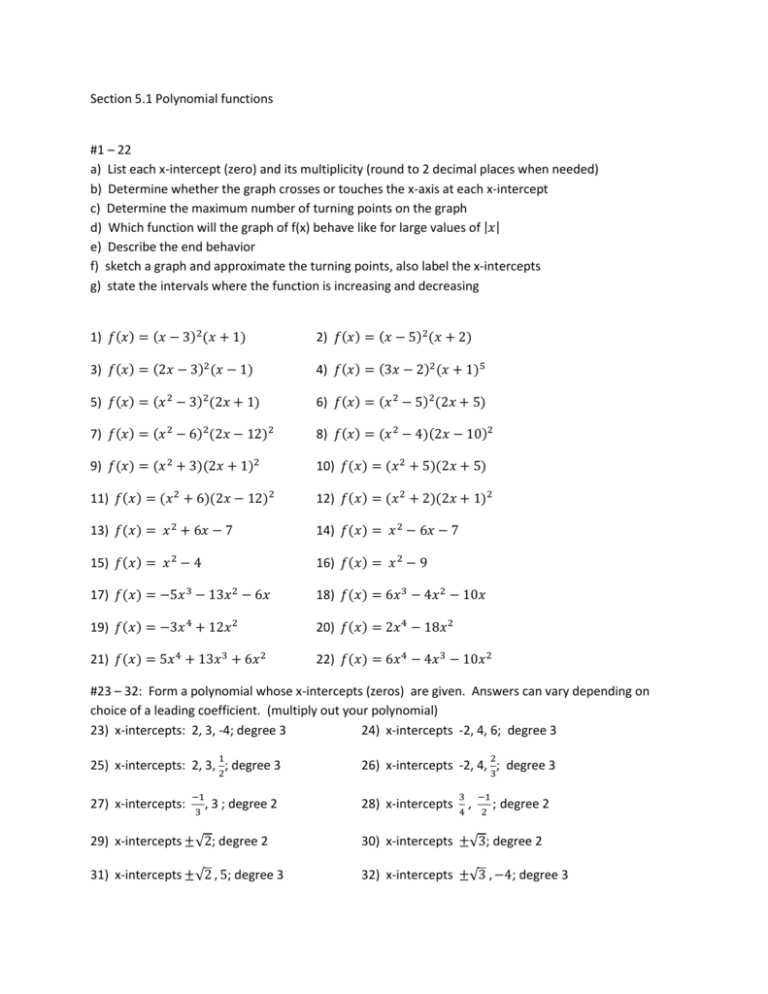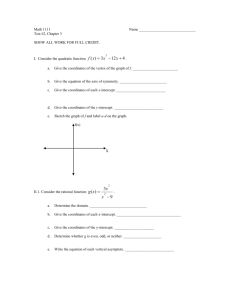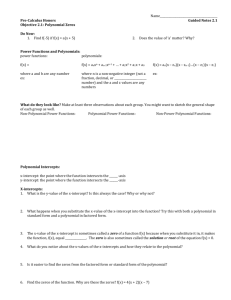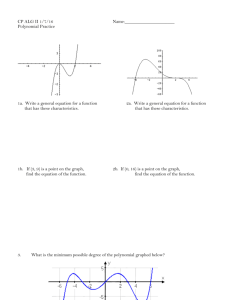chapter 5 problems
advertisement

Section 5.1 Polynomial functions #1 – 22 a) List each x-intercept (zero) and its multiplicity (round to 2 decimal places when needed) b) Determine whether the graph crosses or touches the x-axis at each x-intercept c) Determine the maximum number of turning points on the graph d) Which function will the graph of f(x) behave like for large values of |𝑥| e) Describe the end behavior f) sketch a graph and approximate the turning points, also label the x-intercepts g) state the intervals where the function is increasing and decreasing 1) 𝑓(𝑥) = (𝑥 − 3)2 (𝑥 + 1) 2) 𝑓(𝑥) = (𝑥 − 5)2 (𝑥 + 2) 3) 𝑓(𝑥) = (2𝑥 − 3)2 (𝑥 − 1) 4) 𝑓(𝑥) = (3𝑥 − 2)2 (𝑥 + 1)5 5) 𝑓(𝑥) = (𝑥 2 − 3)2 (2𝑥 + 1) 6) 𝑓(𝑥) = (𝑥 2 − 5)2 (2𝑥 + 5) 7) 𝑓(𝑥) = (𝑥 2 − 6)2 (2𝑥 − 12)2 8) 𝑓(𝑥) = (𝑥 2 − 4)(2𝑥 − 10)2 9) 𝑓(𝑥) = (𝑥 2 + 3)(2𝑥 + 1)2 10) 𝑓(𝑥) = (𝑥 2 + 5)(2𝑥 + 5) 11) 𝑓(𝑥) = (𝑥 2 + 6)(2𝑥 − 12)2 12) 𝑓(𝑥) = (𝑥 2 + 2)(2𝑥 + 1)2 13) 𝑓(𝑥) = 𝑥 2 + 6𝑥 − 7 14) 𝑓(𝑥) = 𝑥 2 − 6𝑥 − 7 15) 𝑓(𝑥) = 𝑥 2 − 4 16) 𝑓(𝑥) = 𝑥 2 − 9 17) 𝑓(𝑥) = −5𝑥 3 − 13𝑥 2 − 6𝑥 18) 𝑓(𝑥) = 6𝑥 3 − 4𝑥 2 − 10𝑥 19) 𝑓(𝑥) = −3𝑥 4 + 12𝑥 2 20) 𝑓(𝑥) = 2𝑥 4 − 18𝑥 2 21) 𝑓(𝑥) = 5𝑥 4 + 13𝑥 3 + 6𝑥 2 22) 𝑓(𝑥) = 6𝑥 4 − 4𝑥 3 − 10𝑥 2 #23 – 32: Form a polynomial whose x-intercepts (zeros) are given. Answers can vary depending on choice of a leading coefficient. (multiply out your polynomial) 23) x-intercepts: 2, 3, -4; degree 3 24) x-intercepts -2, 4, 6; degree 3 1 25) x-intercepts: 2, 3, 2; degree 3 27) x-intercepts: −1 , 3 3 ; degree 2 2 26) x-intercepts -2, 4, 3; degree 3 28) x-intercepts 3 4 , −1 ; 2 degree 2 29) x-intercepts ±√2; degree 2 30) x-intercepts ±√3; degree 2 31) x-intercepts ±√2 , 5; degree 3 32) x-intercepts ±√3 , −4; degree 3 Section 5.2: synthetic division #1- 10: a) Perform the division using synthetic division. b) if the remainder is 0 use the result to completely factor the dividend (this is the numerator or the polynomial to the left of the division sign.) 1) 3𝑥 3 −17𝑥 2 +15𝑥−25 𝑥−5 2) 5𝑥 3 +18𝑥 2 +7𝑥−6 𝑥+3 3) 4𝑥 3 +8𝑥 2 −9𝑥−18 𝑥+2 4) 9𝑥 3 −18𝑥 2 −16𝑥+32 . 𝑥−2 5) 3𝑥 3 −16𝑥 2 −72 𝑥−6 6) 5𝑥 3 −6𝑥 2 +8 𝑥−4 7) (5𝑥 3 + 6𝑥 + 8) ÷ (𝑥 + 2) 8) (𝑥 3 + 512) ÷ (𝑥 + 8) 9) (𝑥 3 − 27) ÷ (𝑥 − 3) 10) (𝑥 3 + 5𝑥 2 ) ÷ (𝑥 + 5) #11 – 20: a) use your graphing calculator, or the rational root theorem to find a zero of the polynomial i) you need to find one zero for a third degree polynomial ii) you need to find two zeros for a fourth degree polynomial b) use synthetic division to completely factor the polynomial (use “double” synthetic division for fourth degree polynomials) 11) f(x) = x3 + 2x2 – 5x – 6 12) f(x) = x3 + 8x2 + 11x -20 13) f(x) = 2x3 – 13x2 + 24x – 9 14) f(x) = 2x3 – 5x2 – 4x + 12 15) f(x) = x4 + x3 – 3x2 – x + 2 16) f(x) = x4 – x3 – 6x2 + 4x+ 8 17) f(x) = 2x4 + 17x3 + 35x2 – 9x – 45 18) f(x) = 4x4 – 15x3 - 8x2 + 15x + 4 19) f(x) = x4 + 7x2 – 8 20) f(x) = x4 - 25x2 +144 #21-30: Solve 21) x4 – x3 + 2x2 – 4x – 8 = 0 22) 2x3 + 3x2 - 2x - 3 = 0 23) 4x3 +8x2 -9x-18 = 0 24) 2x3 – 3x2 – 3x +2 = 0 25) 2x4 +7x3 -4x2 -27x-18 = 0 26) 2x3 – 11x2 + 10x + 8 = 0 27) x4 +4x3 + 2x2 – x + 6 = 0 28) x4 – 2x3 +10x2 – 18x + 9 = 0 29) x4 + 7x2 – 8 = 0 30) x4 + 8x2 – 9 = 0 Section 5.3: #1 – 10: Create a function with lead coefficient 1 that satisfies the conditions. 1) 3) 5) 7) 9) degree 3; zeros -4 and 6 + i degree 3; zeros 2 and 3 - i degree 4; zeros 2i, and 5 – i degree 4; zeros 3i, and 5i degree 4; zeros 2i, 3, - 4 2) degree 3: zeros – 5 and 3 + i 4) degree 3: zeros 7 and 2 – i 6) degree 4; zeros 3i and 4 – i 8) degree 4; zeros 3i and 7i 10) degree 4; zeros 3i, 5 and -6 #11- 24: Use the given solutions to find the remaining solutions to the problem. 11) x3 – 4x2 + 4x – 16 = 0 (x = 2i is a solution) 12) x3 + 3x2 + 25x + 75 (x = 5i is a solution) 13) 2x4 + 5x3 +5x2 +20x-12 = 0 (2i is a solution) 14) OMIT 15) x3 -7x2 – x + 87 = 0 (5 + 2i is a solution) 16) x4 – 7x3 + 14x2 -38x-60= 0 (1+3i is a solution) 17) x4 +6x3 + 2x2 – 26x + 17 = 0 (-4+I is a solution) 18) x4 -14x3 +77x2 -200x+208 = 0 (3 + 2i is a solution) 19) x3 -8x2 +25x-26 = 0 (3+2i is a solution) 20) x3 +13x2 +57x+85=0 (-4 + I is a solution) Section 5.4: Properties of rational functions #1-16: a) find the domain, express your answer using words b) find the equation of the vertical asymptote (if any) 1) 𝑓(𝑥) = 2𝑥−6 𝑥+3 2) 𝑓(𝑥) = 3𝑥−12 2𝑥+6 3) 𝑓(𝑥) = 𝑥 2 −3𝑥−4 5) 𝑓(𝑥) = 3𝑥 2 −10𝑥−8 𝑥 2 −4 6) 𝑓(𝑥) = 3𝑥 2 +20𝑥+12 𝑥 2 −16 7) 𝑓(𝑥) = 9) 𝑓(𝑥) = 3 𝑥−6 10) 𝑓(𝑥) = 𝑥−8 13) 𝑓(𝑥) = 𝑥+2 𝑥 2 +16 3𝑥+12 2 14) 𝑓(𝑥) = 2𝑥 3𝑥−12 𝑥 2 +25 2𝑥−6 𝑥+3 3𝑥+12 19) 𝑓(𝑥) = 𝑥 2 −3𝑥−4 18) 𝑓(𝑥) = 5𝑥 𝑥 2 +9 16) 𝑓(𝑥) = 15) 𝑓(𝑥) = 3𝑥−12 2𝑥+6 3𝑥−18 20) 𝑓(𝑥) = 𝑥 2 +5𝑥−6 3𝑥 2 −10𝑥−8 𝑥 2 −4 22) 𝑓(𝑥) = 23) 𝑓(𝑥) = 𝑥 2 −16 𝑥 3 −𝑥 2 24) 𝑓(𝑥) = 𝑥 3 +5𝑥2 −6𝑥 25) 𝑓(𝑥) = 3 𝑥−6 26) 𝑓(𝑥) = 2 𝑥−8 28) 𝑓(𝑥) = 3𝑥 𝑥 2 −25 30) 𝑓(𝑥) = 3𝑥−12 𝑥 2 +25 2𝑥 𝑥+2 29) 𝑓(𝑥) = 𝑥 2 +16 5𝑥 31) 𝑓(𝑥) = 𝑥 2 +9 3𝑥 2 +20𝑥+12 𝑥 2 −16 3𝑥−18 2𝑥 3𝑥−18 𝑥 3 +5𝑥 2 −6𝑥 12) 𝑓(𝑥) = 21) 𝑓(𝑥) = 27) 𝑓(𝑥) = 𝑥 2 −9 8) 𝑓(𝑥) = 11) 𝑓(𝑥) = 𝑥 2 −9 #1 7– 32 a) find the x-intercept b) find the y-intercept 17) 𝑓(𝑥) = 𝑥 2 −16 𝑥 3 −𝑥 2 3𝑥−18 4) 𝑓(𝑥) = 𝑥 2 +5𝑥−6 32) 𝑓(𝑥) = 𝑥 2 +1 3𝑥 𝑥 2 −25 2𝑥 𝑥 2 +1 Section 5.4: Properties of rational functions #33-48: find the equation of the horizontal asymptote 33) 𝑓(𝑥) = 2𝑥−6 𝑥+3 3𝑥+12 35) 𝑓(𝑥) = 𝑥 2 −3𝑥−4 34) 𝑓(𝑥) = 3𝑥−12 2𝑥+6 3𝑥−18 36) 𝑓(𝑥) = 𝑥 2 +5𝑥−6 37) 𝑓(𝑥) = 3𝑥 2 −10𝑥−8 𝑥 2 −4 38) 𝑓(𝑥) = 39) 𝑓(𝑥) = 𝑥 2 −16 𝑥 2 −𝑥 40) 𝑓(𝑥) = 𝑥 3 +5𝑥2 −6𝑥 41) 𝑓(𝑥) = 3 𝑥−6 42) 𝑓(𝑥) = 2 𝑥−8 44) 𝑓(𝑥) = 3𝑥 𝑥 2 −25 46) 𝑓(𝑥) = 3𝑥−12 𝑥 2 +25 2𝑥 43) 𝑓(𝑥) = 𝑥 2 −9 𝑥+2 45) 𝑓(𝑥) = 𝑥 2 +16 5𝑥 2 47) 𝑓(𝑥) = 𝑥 2 +9 3𝑥 2 +20𝑥+12 𝑥 2 −16 3𝑥−18 2𝑥 48) 𝑓(𝑥) = 𝑥 2 +1 #49 – 58: find the equation of the slant asymptote 49) 𝑓(𝑥) = 𝑥 2 +5𝑥+1 2𝑥+3 50) 𝑓(𝑥) = 8𝑥 2 +3𝑥+2 4𝑥−5 51) 𝑓(𝑥) = 12𝑥 2 +5𝑥+1 4𝑥−5 52) 𝑓(𝑥) = 8𝑥 2 −6𝑥−3 2𝑥+5 53) 𝑓(𝑥) = 2𝑥 2 4𝑥−1 54) 𝑓(𝑥) = 3𝑥 2 12𝑥−5 55) 𝑓(𝑥) = 2𝑥 3 +3𝑥 2 −5 6𝑥 2 +6𝑥−1 56) 𝑓(𝑥) = 8𝑥 3 +4𝑥 2 −3𝑥−1 6𝑥 2 +5𝑥−4 𝑥3 57) 𝑓(𝑥) = 𝑥 2 +1 𝑥3 58) 𝑓(𝑥) = 𝑥 2 +3𝑥−4 Section 5.5: the graph of a rational function For each problem find the following: a) Domain b) Vertical Asymptote (if any) c) Horizontal asymptote, or slant asymptote d) x- intercept(s) if any e) y-intercept(s) if any f) Sketch a graph of the function 1. f ( x) 3x 6 x6 4x 2 9 3. f ( x) 2 x 1 5. f ( x ) 7. 3 5x f ( x) 9. f ( x) 4 x 12 2x 2 x2 4 4. f ( x) 4x 2 1 4 6. 𝑓(𝑥) = 3𝑥 x3 x 2 16 3x 2 8 x 5 x5 11) 𝑓(𝑥) = 2. f ( x) 2𝑥 2 4𝑥−1 8. f ( x) x 1 x 4 x 12 10. f ( x) 2 2 x 2 5x 3 x3 3𝑥 2 12) 𝑓(𝑥) = 12𝑥−5 13) f ( x) 3 x 12 2x 6 14) f ( x) 3 x5 15) f ( x ) 1 x 16) f ( x) x2 x3 17) f ( x ) x5 x2 18) 𝑓(𝑥) = 3𝑥 𝑥 2 −25 Section 5.6: Quadratic and rational inequalities Solve 1) x2 + 6x – 7 < 0 2) x2 + 5x – 6 < 0 3) x2 – 6x + 5 < 0 4) x2 – 4x + 3 < 0 5) 𝑥 2 + 9𝑥 − 10 ≤ 0 6) 𝑥 2 + 2𝑥 − 8 ≤ 0 7) 𝑥 2 − 5𝑥 − 6 ≤ 0 8) 𝑥 2 − 4𝑥 − 5 ≤ 0 9) x2 + 6x – 7 > 0 10) x2 + 5x – 6 > 0 11) x2 – 6x + 5 > 0 12) x2 – 4x + 3 > 0 13) 𝑥 2 + 9𝑥 − 10 ≥ 0 14) 𝑥 2 + 2𝑥 − 8 ≥ 0 15) 𝑥 2 − 5𝑥 − 6 ≥ 0 16) 𝑥 2 − 4𝑥 − 5 ≥ 0 17) 𝑥−3 𝑥−6 <0 18) 𝑥−2 𝑥−9 <0 19) 𝑥+5 𝑥−6 <0 20) 𝑥+2 𝑥−4 <0 21) 𝑥−3 𝑥−7 >0 22) 𝑥−1 𝑥−5 >0 23) 𝑥+1 𝑥+5 >0 24) 𝑥+2 𝑥+6 >0 25) 𝑥−4 𝑥+2 <0 26) 𝑥−5 𝑥+1 <0 Chapter 5 review For problems 1 – 3: a) List each x-intercept (zero) and its multiplicity (round to 2 decimal places when needed) b) Determine whether the graph crosses or touches the x-axis at each x-intercept c) Determine the maximum number of turning points on the graph d) Which function will the graph of f(x) behave like for large values of |𝑥| e) Describe the end behavior f) sketch a graph and approximate the turning points, also label the x-intercepts g) state the intervals where the function is increasing and decreasing 1) 𝑓(𝑥) = (𝑥 − 5)2 (𝑥 − 3) 2) 𝑓(𝑥) = (𝑥 2 − 16)(3𝑥 − 21) 3) 𝑓(𝑥) = 𝑥 4 − 4𝑥 3 − 21𝑥 2 For problems 4 – 5: a) use your graphing calculator, or the rational root theorem to find a zero of the polynomial i) you need to find one zero for a third degree polynomial ii) you need to find two zeros for a fourth degree polynomial b) use synthetic division to completely factor the polynomial (use “double” synthetic division for fourth degree polynomials) 4) f(x) = x3 + x2 – 9x– 9 5) f(x) = x4 +3x3 -8x2 -12x +16 #6-7: Solve 6) x4 – 13x2 + 36 = 0 7) x3 + x2 + 2x + 2= 0 #8-9: Create a function with lead coefficient 1 that satisfies the conditions. 8) degree 3; zeros -2 and 3 + i 9) degree 3: zeros – 5 and 4i 10 – 12 For each problem find the following: a) Domain b) Vertical Asymptote (if any) c) Horizontal asymptote, or slant asymptote d) x- intercept(s) if any e) y-intercept(s) if any f) Sketch a graph of the function : label all the features found in parts b - e 10. f ( x ) 2x 6 x3 11. f ( x) x 1 2 x 4 x 21 12. f ( x) 2x 2 7x 5 x5 #13 – 16: Solve 13) x2 + 6x – 16 < 0 16) 𝑥+4 𝑥−2 >0 14) x2 + 5x – 24 > 0 15) 𝑥−4 𝑥−6 <0 Grima MAT 151 1) a) b) c) d) e) Chapter 5 practice test f(x)=x3 + 2x2 – 8x List each x-intercept (zero) and its multiplicity (round to 2 decimal places when needed) Which function will the graph of f(x) behave like for large values of |𝑥| Describe the end behavior sketch a graph and approximate the turning points, also label the x-intercepts state the intervals where the function is increasing and decreasing (round to 2 decimals) 2) f(x) = 2x3 - 3x2 – 17x - 12 a) use your graphing calculator, or the rational root theorem to find a zero of the polynomial b) use synthetic division to completely factor the polynomial 3) Solve: 2x3 - 3x2 – 17x - 12= 0 (hint use your answer to question 2b) 4) Create a function with lead coefficient 1 that satisfies the conditions; degree 3: zeros 6 and 5i 5) Solve: x2 + 3x – 10 < 0 6) f ( x ) a) b) c) d) e) f) Domain Vertical Asymptote (if any) Horizontal asymptote, or slant asymptote x- intercept(s) if any y-intercept(s) if any Sketch a graph of the function : label all the features found in parts b - e 7. f ( x) a) b) c) d) e) f) 2x 8 x2 x 10 x 4x 5 2 Domain Vertical Asymptote (if any) Horizontal asymptote, or slant asymptote x- intercept(s) if any y-intercept(s) if any Sketch a graph of the function : label all the features found in parts b – e 1a) (-4,0) odd (0,0) odd (2,0) odd 1b) like x3 1c) falls to the left, rises to the right 1d) 1e) increasing (−∞, −2.43) ∪ (1.09, ∞) decreasing (-2.43, 1.09) 2a) x = 4 (also x = -1) 2b) f(x) = (x-4)(x+1)(2x+3) 3) x = 4, -1, -3/2 4) f(x) = x3 – 6x2 + 25x - 150 5) -5 < x < 2 6a) 6b) 6c) 6d) 6e) Domain all real numbers except 2 x =2 y=2 (-4,0) (0, -4) 6f) 7a) 7b) 7c) 7d) 7e) 7f) Domain all real numbers except x = -5,1 x = -5 and x = 1 y=0 (-10, 0) (0,-2)







